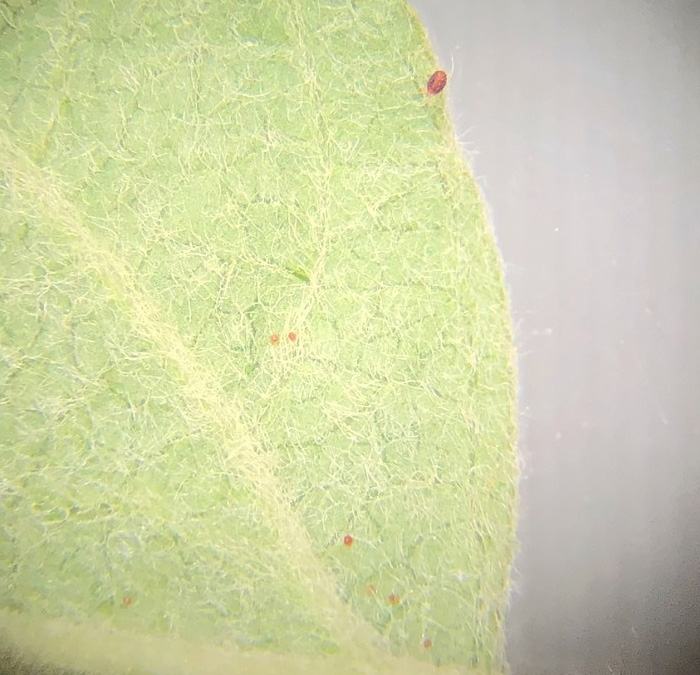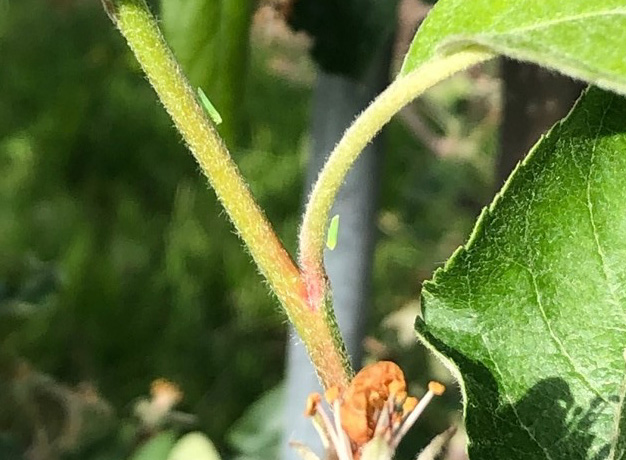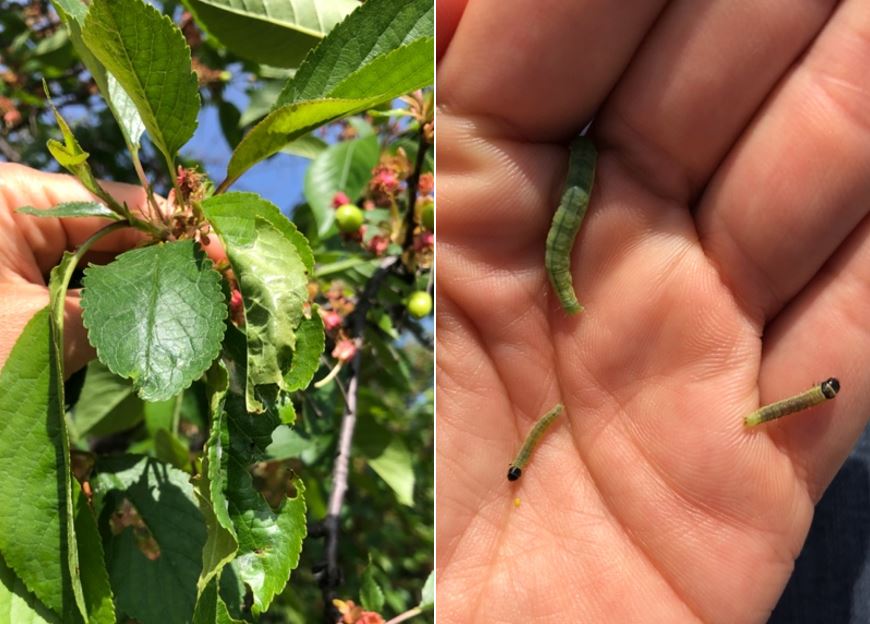Northwest Michigan fruit update – June 9, 2020
Apples are starting to thin and growers are preparing for rainy weather ahead.

Weather report
The weather continues to fluctuate from cool to pretty hot over the last week, and according to Jeff Andresen, Michigan State University agricultural meteorologist, this changing weather pattern will continue for the remainder of the week. Overall, the weather has been warmer and drier compared to the earlier part of the spring. The lowest daytime temperature for the past few days was on Saturday, June 6, at 62 degrees Fahrenheit with a nighttime low of 49.2 F. We jumped almost 15 degrees yesterday, June 8, where the Northwest Michigan Horticulture Research Center’s Enviroweather station recorded a daytime high of 86.8 F.
These warmer conditions have resulted in an accumulation of growing degree days (GDD) across the state and region. Some regions of Michigan have jumped ahead of normal with the recent warmer weather. In northwest Michigan, we have accumulated 659 GDD base 42 and 354 GDD base 50. These accumulations are approaching our 25-plus-year average: 784.3 GDD base 42 and 414.1 GDD base 50.
|
Growing degree days (GDDs) through June 8, 2020 | |||||||
|---|---|---|---|---|---|---|---|
|
Year |
2020 |
2019 |
2018 |
2017 |
2016 |
2015 |
30 Yr. Avg. |
|
GDD42 |
659 |
575 |
788 |
785 |
818 |
709 |
784.3 |
|
GDD50 |
354 |
271 |
456 |
393 |
439 |
419 |
414.1 |
As has been fairly usual for 2020, the weather pattern ahead will change abruptly as a new front will be coming through from the west. This front is from the Caribbean and will bring more warm weather today coupled with some rainfall. However, this warm front will be followed by a cold front, which may result in some potentially severe storms in the western part of the state; the potential for storms is highest on Wednesday with some lingering showers on Thursday. After that storm front moves through, the temperatures will be in the highs in the 60s and lows in the 40s, which is much cooler than expected for this time during the season.
Next week, conditions will moderate with warmer temperatures but still below normal precipitation. In addition to the changing weather patterns, there will be higher than normal winds with the second front that will move through in the next two days. Growers are covering new tissue that has moved quickly in the recent heat prior to the potential rain on Wednesday/Thursday but also before the sustained winds that will move into the state this week. There has been little to no rainfall in the past week, and soils are starting to dry out despite the adequate rainfall from earlier in the season.
Review Andresen’s weather report below for June 9, 2020.
Crop report
With the warm conditions over the past week and more recent heat in the past two days, crop development is moving along fairly quickly. All varieties of sweet cherries and both Balaton and Montmorency are all similar size at the Northwest Michigan Horticulture Research Center: all cherries are in the 10-11 millimeter range. Apples are also starting to size and are at 6 millimeters.
Start thinking about thinning apples soon because when the cold temperatures move in, fruit will be harder to thin in those conditions. The carbohydrate model is showing trees will not be in deficit (Figures 1 and 2), and trees will be much harder to thin. In addition, the daytime highs are predicted to be in the low 90s today and 83 F tomorrow but will drop into the 60s by the weekend. Depending on the stage of development (Northwest Michigan Horticulture Research Center is at 6 millimeters), make your thinning decisions before the fruit is too big to thin, about 20 millimeters.
Also, check the size of your fruit as you may be surprised how fast the fruit have grown in the past week. At the Northwest Michigan Horticulture Research Center, Honeycrisp was at petal fall on June 1, and when we measured the fruit yesterday, June 8, the fruit had grown to 6 millimeters in one week.
Additionally, we conducted our first precision orchard management measurements in both Gala and Honeycrisp and we observed many fruitlets already started to fall off; NAA was applied late last week. There also seem to be quite a bit of variability in size among the fruitlets in all clusters we measured; many of the small fruitlets are likely going to drop.


Pest report
As noted previously, drier, warmer weather over the past has been good conditions for growers to put on thinners and to cover up for pests and diseases between windy conditions.
The apple blocks at the Northwest Michigan Horticulture Research Center are looking mostly free of fire blight symptoms (i.e., no ooze), but there are a few suspect terminals that are flagging. We will continue to monitor the block where we had fire blight last year. Symptoms should be visible soon if infection occurred in the orchard, particularly with this warm weather.
A potentially windy and stormy few days ahead are a concern for trauma blight. Fortunately for the northwest region, the most severe weather is currently predicted to stay further south in the state. Blocks under an Apogee program have shown to be better able to withstand possible trauma blight conditions.
RIMpro models are showing that the end of primary apple scab season is near. Spores are nearing 100% maturity (biofix April 26-27) and currently the model is showing that remaining spores could discharge in the rains predicted to begin this evening, June 9, and last through Thursday, June 11, in the Benzonia and Williamsburg area. The RIMpro output for East Leland suggests this week will not be the end for primary in areas further to the north in the region. The most recent wetting event, June 5-6, was not an infection for most of the region with the exception of Bear Lake and Benzonia, according to MSU Enviroweather. The last significant scab infections occurred in late May, and symptoms from then could become visible this week.
Cherry leaf spot lesions are active with conidia visible on lesions (Photo 1). Trees at the Northwest Michigan Horticulture Research Center that have not been treated with fungicide have lesions with white conidia on bract leaves and early leaves that were infected during wet weather in May. Trees under a fungicide program at the station have fewer lesions, and we have received reports that a few lesions are also visible in commercial orchards. Growers have been covering ahead of the coming rains, and this preventative strategy will minimize the risk of the conidia currently present on leaves to spread and infect adjacent leaves.
Powdery mildew has not been observed, but first cover timing in cherries is the time to include a material for this disease.
In apples, we set biofix for codling moth on June 1. Moth catches were slightly higher this week at the station, and we are over the treatment threshold (i.e., a cumulative catch of five moths in a trap in blocks without mating disruption). Since biofix, we have accumulated about 141 GDD base 50 and egglaying is underway. Egg hatch, estimated at 250 GDD base 50 after biofix, is the timing to switch to larvicidal materials for control.
European red mite activity is ongoing and new eggs are being laid on leaves (Photo 2). Orchards that are above threshold may need treatment. Ensure that the product being used will be effective for the life stages of mites that are present in the orchard.

Black stem borer numbers are down this week, from 41 beetles last week to three beetles this week. We have received reports that sawdust toothpicks produced by the beetles as they bore into trees have been visible recently in areas challenged with this pest. Toothpicks will be blown off in windy conditions or washed off in the coming rains. After the beetles have entered the trees, spray applications will not kill the beetles. Trees that show decline due to black stem borer infestation should be removed from the orchard and burned as soon as possible as the beetles could emerge from the removed trees and re-infest the stressed trees in the block later this season.
Spotted tentiform leaf miner numbers remain low this week, and consistent with last week.
Potato leafhoppers and white apple leafhoppers were found this week (Photo 3). Differentiating these two leafhoppers can be a challenge. Potato leafhoppers tend to move side to side when disturbed whereas white apple leafhoppers move forward and backward.

Obliquebanded leafroller larvae have grown and some may begin pupating soon. We have found very few larvae in apples at the station, however, larvae are not difficult to find in tart cherries that have not been treated with insecticides for a few years (Photo 4). It is time to put out traps to monitor for the adult moths.

The first flight of male San Jose scale is underway, and trap numbers are rising in apples and sweet cherries. The next timing for management is when crawlers are active. Crawler activity is estimated to begin at around 400 GDD base 51 with peak activity occurring at around 600 GDD base 50. Hence, crawler activity could begin early next week at the Northwest Michigan Horticulture Research Center as we are estimated to have accumulated 399 GDD base 51 on Sunday, June 14.
Both tart and sweet cherries at the station have plum curculio ovipositional scars, but small apple fruits have not been targeted at this time. According to degree days, this pest is still at its peak activity. As a reminder, MSU’s John Wise and Nikki Rothwell released an updated article on plum curculio management. We have also heard regional reports of high plum curculio numbers.
American plum borer flight is ongoing and trap numbers jumped up this week. According to degree days, we are at the timing for peak flight of this pest. The first lesser peach tree borers were detected this week. Trunk spray applications may be a good idea this year, particularly if a block that needs borer management has not been treated in the last few years. The availability of effective chemistries for this use could be limited in the future.
A female spotted wing Drosophila (SWD) was found at the Northwest Michigan Horticulture Research Center last week. We have a total of 44 traps up at the station and more throughout the region. We have not yet found this pest on commercial farms in the area. This week will be the second week of checking SWD traps. Cherries are not susceptible to this pest at this time.
Growers planning to monitor for cherry fruit fly should put traps up this week.



 Print
Print Email
Email


